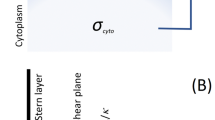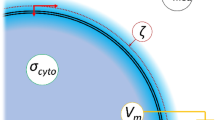Abstract
The plasma membrane functions both as a natural insulator and a diffusion barrier to the movement of ions. A wide variety of proteins transport and pump ions to generate concentration gradients that result in voltage differences, while ion channels allow ions to move across the membrane down those gradients. Plasma membrane potential is the difference in voltage between the inside and the outside of a biological cell, and it ranges from ~− 3 to ~− 90 mV. Most of the most significant discoveries in this field have been made in excitable cells, such as nerve and muscle cells. Nevertheless, special attention has been paid to some events controlled by changes in membrane potential in non-excitable cells. The origins of several blood disorders, for instance, are related to disturbances at the level of plasma membrane in erythrocytes, the structurally simplest red blood cells. The high simplicity of erythrocytes, in particular, made them perfect candidates for the electrophysiological studies that laid the foundations for understanding the generation, maintenance, and roles of membrane potential. This article summarizes the methodologies that have been used during the past decades to determine Δψ in red blood cells, from seminal microelectrodes, through the use of nuclear magnetic resonance or lipophilic radioactive ions to quantify intra and extracellular ions, to continuously renewed fluorescent potentiometric dyes. We have attempted to highlight the advantages and disadvantages of each methodology, as well as to provide a description of the technical aspects involved.





Similar content being viewed by others
References
Amaiden MR et al (2012) Involvement of membrane tubulin in erythrocyte deformability and blood pressure. J Hypertens 30:1414–1422. https://doi.org/10.1097/HJH.0b013e328353b19a
An X, Mohandas N (2008) Disorders of red cell membrane. Br J Haematol 141:367–375. https://doi.org/10.1111/j.1365-2141.2008.07091.x
Barbosa NS, Lima ER, Bostrom M, Tavares FW (2015) Membrane potential and ion partitioning in an erythrocyte using the Poisson-Boltzmann equation. J Phys Chem B 119:6379–6388. https://doi.org/10.1021/acs.jpcb.5b02215
Bennekou P, Kristensen BI, Christophersen P (2003) The human red cell voltage-regulated cation channel. The interplay with the chloride conductance, the Ca(2+)-activated K(+) channel and the Ca(2+) pump. J Membr Biol 195:1–8. https://doi.org/10.1007/s00232-003-2036-6
Blackiston DJ, McLaughlin KA, Levin M (2009) Bioelectric controls of cell proliferation: ion channels, membrane voltage and the cell cycle. Cell Cycle 8:3527–3536. https://doi.org/10.4161/cc.8.21.9888
Brauer M, Spread CY, Reithmeier RA, Sykes BD (1985) 31P and 35Cl nuclear magnetic resonance measurements of anion transport in human erythrocytes. J Biol Chem 260:11643–11650
Bullen A, Saggau P (1999) High-speed, random-access fluorescence microscopy: II. Fast quantitative measurements with voltage-sensitive dyes. Biophys J 76:2272–2287. https://doi.org/10.1016/S0006-3495(99)77383-2
Cabrini G, Verkman AS (1986) Mechanism of interaction of the cyanine dye diS-C3-(5) with renal brush-border vesicles. J Membr Biol 90:163–175
Campetelli A, Bonazzi D, Minc N (2012) Electrochemical regulation of cell polarity and the cytoskeleton. Cytoskeleton (Hoboken) 69:601–612. https://doi.org/10.1002/cm.21047
Catterall WA, Wisedchaisri G, Zheng N (2017) The chemical basis for electrical signaling. Nat Chem Biol 13:455–463. https://doi.org/10.1038/nchembio.2353
Cheng K, Haspel HC, Vallano ML, Osotimehin B, Sonenberg M (1980) Measurement of membrane potentials (psi) of erythrocytes and white adipocytes by the accumulation of triphenylmethylphosphonium cation. J Membr Biol 56:191–201
Choi WG, Hilleary R, Swanson SJ, Kim SH, Gilroy S (2016) Rapid, Long-Distance Electrical and Calcium Signaling in Plants. Annu Rev Plant Biol 67:287–307. https://doi.org/10.1146/annurev-arplant-043015-112130
Cohen LB, Salzberg BM (1978) Optical measurement of membrane potential. Rev Physiol Biochem Pharmacol 83:35–88
Cole RP (2004) Co2 and lung mechanical or gas exchange function. Crit Care Med 32:1240; author reply 1240-1241. https://doi.org/10.1097/01.ccm.0000124855.42182.d0
Cone CD Jr (1971) Unified theory on the basic mechanism of normal mitotic control and oncogenesis. J Theor Biol 30:151–181. https://doi.org/10.1016/0022-5193(71)90042-7
Cortese B, Palama IE, D'Amone S, Gigli G (2014) Influence of electrotaxis on cell behaviour. Integr Biol (Camb) 6:817–830. https://doi.org/10.1039/c4ib00142g
Epps DE, Wolfe ML, Groppi V (1994) Characterization of the steady-state and dynamic fluorescence properties of the potential-sensitive dye bis-(1,3-dibutylbarbituric acid)trimethine oxonol (Dibac4(3)) in model systems and cells. Chem Phys Lipids 69:137–150
Farias LM et al (2004) Ether a go-go potassium channels as human cervical cancer markers. Cancer Res 64:6996–7001. https://doi.org/10.1158/0008-5472.CAN-04-1204
Fraser SP et al (2005) Voltage-gated sodium channel expression and potentiation of human breast cancer metastasis. Clin Cancer Res 11:5381–5389. https://doi.org/10.1158/1078-0432.CCR-05-0327
Freedman JC (2001) 23 - Membrane Transport in Red Blood Cells. In: Sperelakis N (ed) Cell Physiology Source Book, 3rd edn. Academic Press, San Diego, pp 377–392. https://doi.org/10.1016/B978-012656976-6/50115-3
Freedman JC, Hoffman JF (1979) Ionic and osmotic equilibria of human red blood cells treated with nystatin. J Gen Physiol 74:157–185. https://doi.org/10.1085/jgp.74.2.157
Gedde MM, Huestis WH (1997) Membrane potential and human erythrocyte shape. Biophys J 72:1220–1233. https://doi.org/10.1016/S0006-3495(97)78769-1
Glynn IM (1957) The ionic permeability of the red cell membrane. Prog Biophys Biophys Chem 8:241–307
Gordon MJ (1959) The charge on cell membranes. Med Bull (Ann Arbor) 25:170–176
Habela CW, Olsen ML, Sontheimer H (2008) ClC3 is a critical regulator of the cell cycle in normal and malignant glial cells. J Neurosci 28:9205–9217. https://doi.org/10.1523/JNEUROSCI.1897-08.2008
Hodgkin AL (1951) The ionic basis of electrical activity in nerve and muscle. Biol Rev 26:339–409. https://doi.org/10.1111/j.1469-185X.1951.tb01204.x
Hoffman JF, Laris PC (1974) Determination of membrane potentials in human and Amphiuma red blood cells by means of fluorescent probe. J Physiol 239:519–552. https://doi.org/10.1113/jphysiol.1974.sp010581
Jay AW, Burton AC (1969) Direct measurement of potential difference across the human red blood cell membrane. Biophys J 9:115–121. https://doi.org/10.1016/S0006-3495(69)86372-1
Kim CJ et al (2004) Altered expression of KCNK9 in colorectal cancers. APMIS 112:588–594. https://doi.org/10.1111/j.1600-0463.2004.apm1120905.x
Kirk K, Kuchel PW, Labotka RJ (1988) Hypophosphite ion as a 31P nuclear magnetic resonance probe of membrane potential in erythrocyte suspensions. Biophys J 54:241–247. https://doi.org/10.1016/S0006-3495(88)82953-9
Klapperstuck T, Glanz D, Klapperstuck M, Wohlrab J (2009) Methodological aspects of measuring absolute values of membrane potential in human cells by flow cytometry. Cytometry A 75:593–608. https://doi.org/10.1002/cyto.a.20735
Knight DA, Holgate ST (2003) The airway epithelium: structural and functional properties in health and disease. Respirology 8:432–446
Knisley SB, Justice RK, Kong W, Johnson PL (2000) Ratiometry of transmembrane voltage-sensitive fluorescent dye emission in hearts. Am J Physiol Heart Circ Physiol 279:H1421–H1433. https://doi.org/10.1152/ajpheart.2000.279.3.H1421
Koechlin BA (1955) On the chemical composition of the axoplasm of squid giant nerve fibers with particular reference to its ion pattern. J Biophys Biochem Cytol 1:511–529. https://doi.org/10.1083/jcb.1.6.511
Larkin TJ, Bubb WA, Kuchel PW (2007) pH and cell volume effects on H2O and phosphoryl resonance splitting in rapid-spinning NMR of red cells. Biophys J 92:1770–1776. https://doi.org/10.1529/biophysj.106.096149
Lassen UV, Sten-Knudsen O (1968) Direct measurements of membrane potential and membrane resistance of human red cells. J Physiol 195:681–696. https://doi.org/10.1113/jphysiol.1968.sp008482
Lefevre PG (1964) The Osmotically Functional Water Content of the Human Erythrocyte. J Gen Physiol 47:585–603. https://doi.org/10.1085/jgp.47.3.585
Levin M (2007) Large-scale biophysics: ion flows and regeneration. Trends Cell Biol 17:261–270. https://doi.org/10.1016/j.tcb.2007.04.007
Levinson SR, Sather WA (2001) 27 - Structure and Mechanism of Voltage-Gated Ion Channels. In: Sperelakis N (ed) Cell Physiology Source Book, 3rd edn. Academic Press, San Diego, pp 455–477. https://doi.org/10.1016/B978-012656976-6/50119-0
London RE, Gabel SA (1989) Determination of membrane potential and cell volume by 19F NMR using trifluoroacetate and trifluoroacetamide probes. Biochemistry 28:2378–2382
Moersdorf D, Egee S, Hahn C, Hanf B, Ellory C, Thomas S, Bernhardt I (2013) Transmembrane potential of red blood cells under low ionic strength conditions. Cell Physiol Biochem 31:875–882. https://doi.org/10.1159/000350105000350105
Nilius B, Droogmans G (2001) 29 - Ion Channels in Nonexcitable Cells. In: Sperelakis N (ed) Cell Physiology Source Book, 3rd edn. Academic Press, San Diego, pp 485–507. https://doi.org/10.1016/B978-012656976-6/50121-9
Patel F, Brackenbury WJ (2015) Dual roles of voltage-gated sodium channels in development and cancer. Int J Dev Biol 59:357–366. https://doi.org/10.1387/ijdb.150171wb150171wb
Perona R, Serrano R (1988) Increased pH and tumorigenicity of fibroblasts expressing a yeast proton pump. Nature 334:438–440. https://doi.org/10.1038/334438a0
Prindle A, Liu J, Asally M, Ly S, Garcia-Ojalvo J, Suel GM (2015) Ion channels enable electrical communication in bacterial communities. Nature 527:59–63. https://doi.org/10.1038/nature15709
Rodriguez-Garcia R, Lopez-Montero I, Mell M, Egea G, Gov NS, Monroy F (2015) Direct Cytoskeleton Forces Cause Membrane Softening in Red Blood Cells. Biophys J 108:2794–2806. https://doi.org/10.1016/j.bpj.2015.05.005
Salzberg BM, Davila HV, Cohen LB (1973) Optical recording of impulses in individual neurones of an invertebrate central nervous system. Nature 246:508–509. https://doi.org/10.1038/246508a0
Semplicini A, Spalvins A, Canessa M (1989) Kinetics and stoichiometry of the human red cell Na+/H+ exchanger. J Membr Biol 107:219–228
Smith AS et al (2018) Myosin IIA interacts with the spectrin-actin membrane skeleton to control red blood cell membrane curvature and deformability. Proc Natl Acad Sci U S A 115:E4377–E4385. https://doi.org/10.1073/pnas.17182851151718285115
Stein WD, Lieb WR (1986) Transport and diffusion across cell membranes. Academic Press, Orlando
Steinbach HB (1952) On the Sodium and Potassium Balance of Isolated Frog Muscles. Proc Natl Acad Sci U S A 38:451–455. https://doi.org/10.1073/pnas.38.5.451
Sundelacruz S, Levin M, Kaplan DL (2009) Role of membrane potential in the regulation of cell proliferation and differentiation. Stem Cell Rev 5:231–246. https://doi.org/10.1007/s12015-009-9080-2
Teorell T (1952) Permeability properties of erythrocyte ghosts. J Gen Physiol 35:669–701. https://doi.org/10.1085/jgp.35.5.669
Tosteson DC (1959) Halide Transport in Red Blood Cells. Acta Physiol Scand 46:19–41. https://doi.org/10.1111/j.1748-1716.1959.tb01734.x
Warburg EJ (1922) Studies on Carbonic Acid Compounds and Hydrogen Ion Activities in Blood and Salt Solutions. A Contribution to the Theory of the Equation of Lawrence J. Henderson and K. A. Hasselbach: CHAP. VII. Biochem J 16:222–233. https://doi.org/10.1042/bj0160222
Wittenkeller L, Mota de Freitas D, Ramasamy R (1992) Ionophore-induced Cl- transport in human erythrocyte suspensions: a multinuclear magnetic resonance study. Biochem Biophys Res Commun 184:915–921
Yang M, Brackenbury WJ (2013) Membrane potential and cancer progression. Front Physiol 4:185. https://doi.org/10.3389/fphys.2013.00185
Zavodnik IB, Piasecka A, Szosland K, Bryszewska M (1997) Human red blood cell membrane potential and fluidity in glucose solutions. Scand J Clin Lab Invest 57:59–63
Zhang W, Zhu ZY (2015) Structural modification of H histo-blood group antigen. Blood Transfus 13:143–149. https://doi.org/10.2450/2014.0033-142014.0033-14
Acknowledgments
This work was supported by the Consejo Nacional de Investigaciones Científicas y Técnicas (CONICET), Agencia Nacional de Promoción Científica y Tecnológica (ANPCyT, FONCyT PICT 2015-2205), and the Secretary of Science and Technology of Universidad Nacional de Río Cuarto (SECyT-UNRC), Argentina. The authors also thank Florencia Sgarlatta for English editing.
Author information
Authors and Affiliations
Contributions
M.M.B and A.N.C performed the literature search and analysis and drafted the work, C.H.C and A.N.C critically revised the work. This article is an initiative of A.N.C who supervised the work.
Corresponding author
Ethics declarations
Conflict of interest
The authors declare that they have no conflict of interest.
Additional information
Publisher’s note
Springer Nature remains neutral with regard to jurisdictional claims in published maps and institutional affiliations.
Rights and permissions
About this article
Cite this article
Balach, M.M., Casale, C.H. & Campetelli, A.N. Erythrocyte plasma membrane potential: past and current methods for its measurement. Biophys Rev 11, 995–1005 (2019). https://doi.org/10.1007/s12551-019-00603-5
Received:
Accepted:
Published:
Issue Date:
DOI: https://doi.org/10.1007/s12551-019-00603-5




